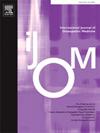有限背屈个体踝足复合体的整骨手法治疗:一项随机交叉临床试验的研究方案
IF 1.5
4区 医学
Q2 MEDICINE, GENERAL & INTERNAL
引用次数: 0
摘要
踝关节背屈活动范围的减少会导致日常功能活动(如行走)的改变。肌筋膜、肌肉和关节技术通常用于恢复这一范围。关节技术通常集中在距骨关节,将脚作为一个刚性节段。本研究旨在提出一个评估和治疗方案的踝关节和足复杂的健康个体减少背屈。将在18-40岁的成年人中进行一项随机交叉临床试验,为期2周的洗脱期和随访,以评估干预效果的保留性。将招募30名参与者,并在干预前后使用负重弓步测试评估踝关节活动范围,以及通过惯性传感器测量的运动学和时空步态变量。干预包括整骨疗法的手法治疗,将针对距骨、胫腓远端、距下、跗骨中关节(Chopart)、跗骨-跖骨关节和跖骨-指骨关节。这项研究已提交给瑞士联邦大学伦理委员会(议定书号:1)。6.917.725),并在巴西临床试验登记处注册(RBR-10rvpcp3)。预计踝关节背屈活动范围的急性改善,以及对时空和运动学步态变量的额外影响,可以帮助临床决策治疗背屈限制。本文章由计算机程序翻译,如有差异,请以英文原文为准。
Osteopathic manipulative treatment of the ankle-foot complex in individuals with limited dorsiflexion: Study protocol for a randomized crossover clinical trial
Reduced ankle dorsiflexion range of motion leads to changes in daily functional activities such as walking. Myofascial, muscular, and joint techniques are commonly used to restore this range. Joint techniques typically focus on the talocrural joint, treating the foot as a rigid segment. This study aims to propose an evaluation and treatment protocol for the ankle and foot complex in healthy individuals with reduced dorsiflexion. A randomized crossover clinical trial, with a 2-week washout period and follow-up to assess the retention of the intervention's effects, will be conducted in adults aged 18–40 years. Thirty participants will be recruited and assessed before and after intervention for ankle range of motion using the weight-bearing lunge test, as well as for kinematic and spatiotemporal gait variables measured by inertial sensors. The intervention, consisting of osteopathic manipulative treatment, will target the talocrural, distal tibiofibular, subtalar, midtarsal (Chopart), tarsal-metatarsal, and metatarsal-phalangeal joints. This study has been submitted to the Ethics Committee of the Universidade Federal de Juiz de Fora (protocol no. 6.917.725) and registered in the Brazilian Registry of Clinical Trials (RBR-10rvpcp3). An acute improvement in ankle dorsiflexion range of motion is expected, along with additional effects on the spatiotemporal and kinematic gait variables, which could assist in clinical decision-making for treating dorsiflexion limitations.
求助全文
通过发布文献求助,成功后即可免费获取论文全文。
去求助
来源期刊
CiteScore
2.20
自引率
36.80%
发文量
42
审稿时长
3 months
期刊介绍:
The International Journal of Osteopathic Medicine is a peer-reviewed journal that provides for the publication of high quality research articles and review papers that are as broad as the many disciplines that influence and underpin the principles and practice of osteopathic medicine. Particular emphasis is given to basic science research, clinical epidemiology and health social science in relation to osteopathy and neuromusculoskeletal medicine.
The Editorial Board encourages submission of articles based on both quantitative and qualitative research designs. The Editorial Board also aims to provide a forum for discourse and debate on any aspect of osteopathy and neuromusculoskeletal medicine with the aim of critically evaluating existing practices in regard to the diagnosis, treatment and management of patients with neuromusculoskeletal disorders and somatic dysfunction. All manuscripts submitted to the IJOM are subject to a blinded review process. The categories currently available for publication include reports of original research, review papers, commentaries and articles related to clinical practice, including case reports. Further details can be found in the IJOM Instructions for Authors. Manuscripts are accepted for publication with the understanding that no substantial part has been, or will be published elsewhere.

 求助内容:
求助内容: 应助结果提醒方式:
应助结果提醒方式:


